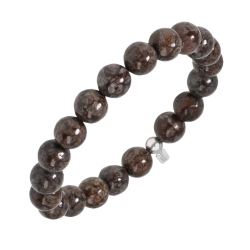Alabaster - knowledge base, jewelry
Properties of alabaster, physiological effects, zodiac signs and alabaster jewelry.




Alabaster is nothing more than a fine-grained version of gypsum.
Alabaster is originally of Greek origin. Crystal structure: monoclinic. The way alabaster is formed is sedimentary. Alabaster occurs in a mixture with granular or leaf plaster.
It is found in the lower levels of the gypsum mines. It got its name from antiquity in a block of plaster found in the Alabaster mountains. In the past, a finer version of limestone was also considered alabaster.
Chemical and physical properties of alabaster:
Formula:
CaSO4 - 2H2O Calcium sulfate
Color:
white, brown, rose
Streak:
white
Transparency:
opaque
Cleavage:
none
Mohs scale hardeness:
2,0
Specific gravity:
2,3 – 2,33 g/cm³
Major physiological effects attributed to alabaster:
It has a heart chakra-releasing, heart-healing, soul-strengthening and calming effect, it dissolves muscle cramps, strengthens tissues, helps fertility, and helps set self-limits.
Alabaster jewelry is part of our range.
For more jewelry please click here!
Major versions of the alabaster
- Selenite: it is colorless and soft, so it is only polished for collectors.
- Satin Pate: This is a fibrous version that is polished or polished to a chabochon shape. The pink hue of this is called the “Desert Rose”.
Occurence of alabaster
It is used quite rarely in the field of jewelry, it is used to make ornaments.
It can be painted well because its material, like gypsum, is highly porous.
The most important sites of the alabaster
France, Mexico, Italy, England, Chile, USA.






